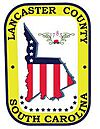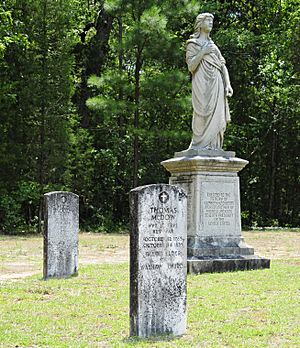Lancaster County, South Carolina facts for kids
Quick facts for kids
Lancaster County
|
|||
|---|---|---|---|
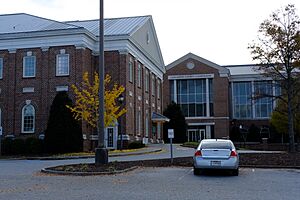
Lancaster County Courthouse
|
|||
|
|||
| Motto(s):
"Discover Lancaster County, South Carolina"
|
|||
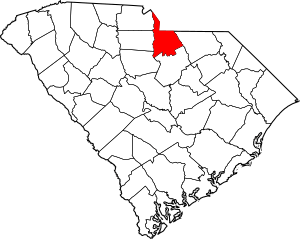
Location within the U.S. state of South Carolina
|
|||
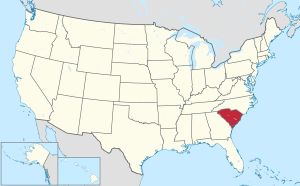 South Carolina's location within the U.S. |
|||
| Country | |||
| State | |||
| Founded | 1785 | ||
| Named for | House of Lancaster | ||
| Seat | Lancaster | ||
| Largest community | Lancaster | ||
| Area | |||
| • Total | 555.05 sq mi (1,437.6 km2) | ||
| • Land | 549.07 sq mi (1,422.1 km2) | ||
| • Water | 5.98 sq mi (15.5 km2) 1.08% | ||
| Population
(2020)
|
|||
| • Total | 96,016 | ||
| • Estimate
(2023)
|
108,215 |
||
| • Density | 172.9862/sq mi (66.7904/km2) | ||
| Time zone | UTC−5 (Eastern) | ||
| • Summer (DST) | UTC−4 (EDT) | ||
| Congressional district | 5th | ||
Lancaster County is a county in the state of South Carolina, USA. In 2020, about 96,016 people lived here. The main town and county seat is Lancaster. This county was created in 1785. It is part of the larger Charlotte metropolitan area, which includes cities in both North and South Carolina. Lancaster County is located in the Piedmont region, an area of rolling hills at the base of mountains.
Contents
History of Lancaster County
For many hundreds of years, the Catawba Indians lived in and claimed all the land that is now Lancaster County. The Catawba were a very strong tribe in the Southeastern United States. They were known for their farming skills and were friendly with the first European settlers who arrived.
The first White settlers came to this area in the early 1750s. They built their homes near Rum Creek and Twelve Mile Creek. Many of these new settlers were Scots-Irish people who came from Pennsylvania. Others moved here from North Carolina and Virginia.
Many early settlers came from a place called Lancaster in England. They named their new county after the House of Lancaster. This was a powerful family in England that fought against the House of York in a series of wars. These wars, from 1455 to 1485, were known as the War of the Roses. The House of Lancaster used a red rose as its symbol. Nearby York County in South Carolina uses a white rose, just like the House of York.
Another group of settlers made their homes in the southern part of Lancaster County. They settled near Hanging Rock Creek. The creek got its name from a huge rock that hangs over it. Other settlers came to live along Lynches Creek, Little Lynches Creek, Flat Creek, Beaver Creek, and lower Camp Creek. When the first settlers arrived, they followed old Native American paths. These paths later became the first roads in the area.
One important old road was the Rocky River Road. During the American Revolutionary War, a battle happened near here. Colonel Abraham Buford and his Patriot forces were defeated by British troops. This event is sometimes called Buford's Massacre. Today, parts of the Rocky River Road are now South Carolina Highway 522.
Geography of Lancaster County
Lancaster County covers a total area of about 555 square miles. Most of this area, about 549 square miles, is land. The remaining 6 square miles, or about 1.1%, is water. The Catawba River and Sugar Creek form the western border of the county. The Lynches River forms the eastern border.
Neighboring Counties
Lancaster County shares borders with several other counties:
- Union County, North Carolina - to the northeast
- Chesterfield County - to the east
- Kershaw County - to the south
- Fairfield County - to the southwest
- York County - to the west
- Chester County - to the west
- Mecklenburg County, North Carolina - to the north
People in Lancaster County (Demographics)
| Historical population | |||
|---|---|---|---|
| Census | Pop. | %± | |
| 1790 | 6,302 | — | |
| 1800 | 6,012 | −4.6% | |
| 1810 | 6,318 | 5.1% | |
| 1820 | 8,716 | 38.0% | |
| 1830 | 10,361 | 18.9% | |
| 1840 | 9,907 | −4.4% | |
| 1850 | 10,988 | 10.9% | |
| 1860 | 11,797 | 7.4% | |
| 1870 | 12,087 | 2.5% | |
| 1880 | 16,903 | 39.8% | |
| 1890 | 20,761 | 22.8% | |
| 1900 | 24,311 | 17.1% | |
| 1910 | 26,650 | 9.6% | |
| 1920 | 28,628 | 7.4% | |
| 1930 | 27,980 | −2.3% | |
| 1940 | 33,542 | 19.9% | |
| 1950 | 37,071 | 10.5% | |
| 1960 | 39,352 | 6.2% | |
| 1970 | 43,328 | 10.1% | |
| 1980 | 53,361 | 23.2% | |
| 1990 | 54,516 | 2.2% | |
| 2000 | 61,351 | 12.5% | |
| 2010 | 76,652 | 24.9% | |
| 2020 | 96,016 | 25.3% | |
| 2023 (est.) | 108,215 | 41.2% | |
| U.S. Decennial Census 1790–1960 1900–1990 1990–2000 2010–2020 |
|||
What the 2020 Census Showed
| Race | Num. | Perc. |
|---|---|---|
| White (non-Hispanic) | 64,927 | 67.62% |
| Black or African American (non-Hispanic) | 19,101 | 19.89% |
| Native American | 220 | 0.23% |
| Asian | 1,765 | 1.84% |
| Pacific Islander | 14 | 0.01% |
| Other/Mixed | 3,695 | 3.85% |
| Hispanic or Latino | 6,294 | 6.56% |
In 2020, there were 96,016 people living in Lancaster County. There were 35,410 households and 24,327 families.
What the 2010 Census Showed
In 2010, there were 76,652 people living in the county. About 71.5% of the people were White, and 23.8% were Black or African American. About 4.4% of the population was of Hispanic or Latino origin. The average age of people in the county was 39.7 years old.
Economy
In 2022, the total value of all goods and services produced in Lancaster County was about $4.3 billion. This is known as the GDP.
Some of the biggest employers in the county include popular stores like Food Lion and Walmart. Many people in Lancaster County work in different areas such as healthcare, retail, and manufacturing.
Communities in Lancaster County
City
- Lancaster (This is the main town and where the county government is located.)
Towns
Census-Designated Places
These are areas that are like towns but are not officially incorporated as cities or towns.
Unincorporated Communities
These are smaller communities that are not officially part of a city or town.
Notable People from Lancaster County
Many interesting people have come from Lancaster County, including:
- Bill Belk, a professional football player
- Sheldon Brown, a professional football player
- Danny Clyburn, a professional baseball player
- Shawn Crawford, an Olympic gold medalist in sprinting
- Charles Duke, an astronaut who walked on the Moon during the Apollo 16 mission
- James "Butch" Duncan, a professional NFL player
- Jim Hodges, a former Governor of South Carolina
- Andrew Jackson, the seventh President of the United States
- Nina Mae McKinney, an actress and Broadway star
- Julie Roberts, a country music singer
- Aaron Robinson, a Major League Baseball player
- Nelson Sullivan, a video artist
- J. Marion Sims, a famous surgeon
- The Zodiacs, an R&B vocal group
- Jeff Twitty, a professional baseball player
- Brian Williams, a professional baseball player
See also
 In Spanish: Condado de Lancaster (Carolina del Sur) para niños
In Spanish: Condado de Lancaster (Carolina del Sur) para niños


